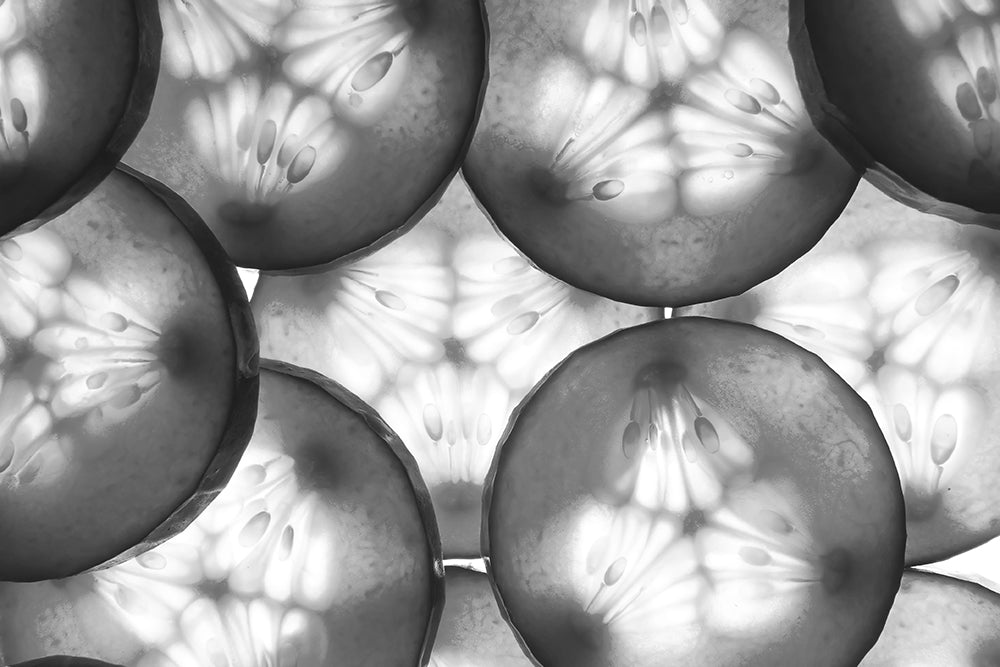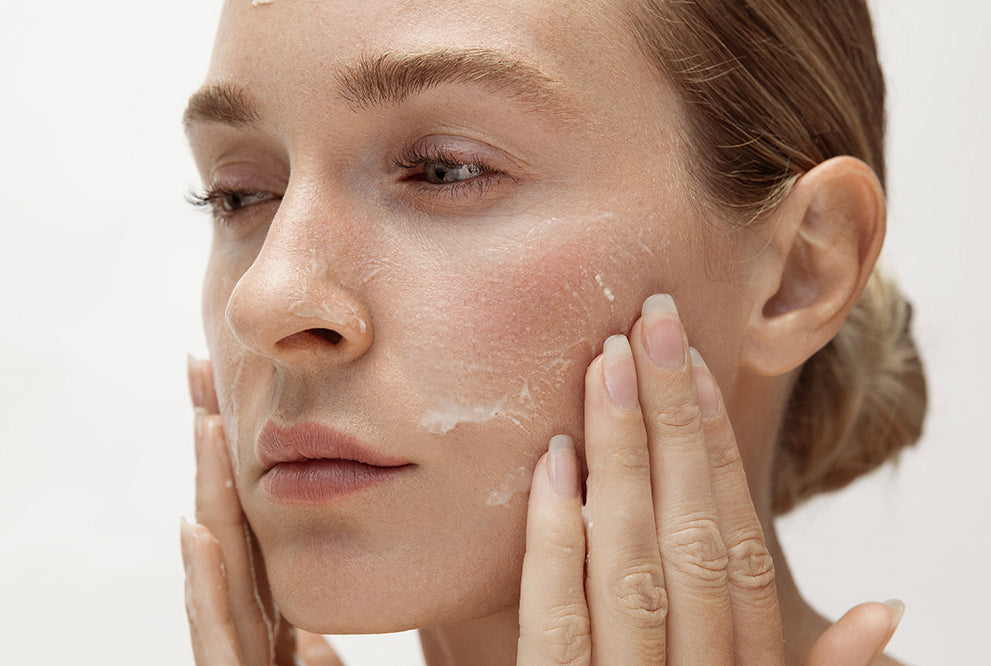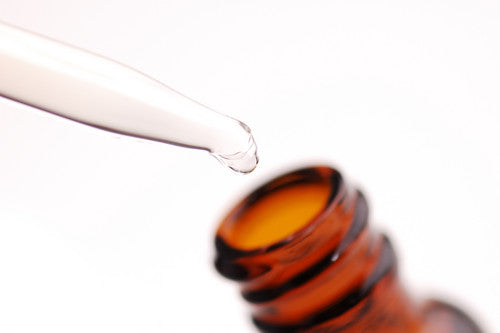
ingredient focus: cucumber

the bottom line
More than just an ingredient for your daily salad, the humble cucumber has tremendous therapeutic and cosmetic benefits. Possessing minerals, fatty acids, and vitamins, the cucumber’s leaves, fruit, and seeds have traditionally been used for a range of skin problems, including swelling, sunburn, and irritation. Keep reading to learn more about the science and function of this green beauty.
first layer: the history of cucumber
The cucumber, or Cucumis sativus, has been widely cultivated throughout the world for the past 3000 years with its origins in the Himalayas, China, Thailand, and India. It is not an endangered ingredient and therefore its use in cosmetics is considered sustainable. The cucumber is a vine plant of the Cucurbitaceae family which also contains squash, watermelon, zucchini, and pumpkin.
The cucumber is believed to have been introduced to Europe by the Greeks or Romans. The Emperor Tiberius reportedly had cucumber served daily during both summer and winter, and Charlemagne is said to have grown cucumbers in the 8th and 9th centuries. They were introduced into England in the 14th century, and North America by the 16th century. By the 17th century, however, a bias had developed against uncooked vegetables and fruits, resulting in a temporary fall from grace of the cucumber.
second layer: the science of cucumber
Both the fruit and the seed of the cucumber have active components. Cucumber seed oil is obtained by cold pressing the cleaned and dried seeds of the Cucumis sativus vine. The extract is then filtered to obtain a brilliant, clear yellow liquid which has a fresh and bright aroma. The primary components of cucumber include linoleic acid (60%), phytosterols*, ascorbic acid (vitamin C), and curcubatacins.
Linoleic acid is derived from the seeds of the cucumber, which also includes palmitic acid (9-13%), stearic acid (6-9%), oleic acid (14-20%), palmitoleic acid (<1%), and linolenic acid (<1%). Linoleic acid is an omega-6 polyunsaturated fatty acid found naturally in the epidermis. It has a role in the structure and function of the lipid barrier of the skin and is a precursor to certain ceramides and anti-inflammatory mediators. Linoleic acid and its ceramides may be lower during colder weather, resulting in an impaired skin barrier. Lower levels of linoleic are also noted in certain skin conditions including atopic dermatitis* and acne. One study found that the topical use of oils rich in linoleic acid increases the levels of ceramides from linoleic acid within the stratum corneum of the epidermis. Finally, linoleic acid assists in the reduction of melanin production.
Phytosterols from cucumber seeds are plant-based compounds structurally similar to cholesterol, one of the major skin barrier lipids. Phytosterols promote skin renewal by stimulating cellular metabolism and promoting repair of the skin barrier. Transepidermal water loss (TEWL)* decreases with repair of the skin barrier, resulting in more hydrated skin. Phytosterols also act as anti-inflammatory agents to help soothe skin. The two primary phytosterols found in cucumber seeds are spinasterol and dihydrospinasterol, which act as antioxidants* and skin conditioning agents. In one in vitro study, spinasterol was shown to promote the synthesis of procollagen* in dermal fibroblasts*.
Also present within the fruit of the cucumber are curcubitacins, biochemical compounds produced by plants in the Cucurbitaceae family. Curcubitacins C and D have demonstrated inhibition of tyrosinase and melanin synthesis, resulting in the reduction of skin pigmentation.
Finally, L-ascorbic acid, or vitamin C, is found within the fruit of the plant. Vitamin C is a potent antioxidant which can reduce damage secondary to exposure to ultraviolet radiation. It also increases the levels of collagen I and III, while promoting the production of elastin in the dermis. Caffeic acid is also present and has anti-inflammatory and antioxidant effects. The juice of the cucumber fruit has additionally shown anti-elastase*, and anti-hyaluronidase* activity. Lactic acid is also present within the pulp, which assists in chemical exfoliation of the skin.
third layer: cucumber in skin care
Cucumber water and cucumber seed oil provide a number of benefits to the skin and hair:
- soothing: extracts from cucumber are cooling and gentle, ideal for those with sensitive skin.
- antioxidant: the phytosterols spinasterol and dihydrospinasterol within cucumber seed oil, as well as antioxidants with the fruit juice, help fight free radicals*.
- skin brightening: both curcubitacins and vitamin C are effective in helping to reduce excess pigmentation on the skin.
- skin barrier repair: the phytosterols and fatty acids present within cucumber seed oil help to support the skin barrier, which in turn decreases TEWL.
- moisturizing: the high level of fatty acids and phytosterols found within cucumber seeds assist in increasing hydration of the skin.
- anti-aging: the enzymes hyaluronidase, which breaks down hyaluronic acid, and elastase, which breaks down elastin, are inhibited by cucumber fruit extract. As a result, wrinkles appear less prominent and skin has improved elasticity.
fourth layer: how we do it
Cucumber seed oil forms the nourishing base of our bakuchiol & pomegranate facial oil, a luxurious natural retinol alternative created to target fine lines and wrinkles, hyperpigmentation, and acne. It provides all the benefits of retinol, none of the red, flaky, side effects.
All this and more at www.anokhaskincare.com .
xx
anokha
references:
- formulabotanica.com
- https://en.wikipedia.org/wiki/Cucumber
- Mukherjee PK, Nema NK, Maity N, Sarkar B. Phytochemical and therapeutic potential of cucumber. Fitoterapia 2013; 84: 227-236.
- Nema NK, Maity N, Sarkar B, Mukherjee PK. Cucumis sativus fruit – potential antioxidant, anti-hyaluronidase, and anti-elastase agent. Arch Dermatol Res 2011; 303: 247-252.
- Akhtar N, Mehmood A, Khan BA, et al. Exploring cucumber extract for skin rejuvenation. Afr J Biotechnol 2011; 10:1206-1216.
- Jian CC, Ming C, Rui LN, Geoffrey AC, Samuel XQ. Curcubitacins and curcubitane glycosides: structures and biological activities. Nat Prod Rep 2005; 22: 386-399.
- Sotiroudis G, Melliou Sotiroudis E, Chinou I. Chemical analysis, antioxidant and antimicrobial activity of three Greek cucumber (Cucumis sativus) cultivars. J Food Biochem 2010; 34: 61-78.
*definitions:
antioxidant: an antioxidant is a compound that inhibits oxidation. free radicals create oxidative stress and an inflammatory response which in turn can damage DNA and result in injury to the epidermal and dermal layers of the skin. in the skin, this manifests as premature aging with decreased elasticity leading to increased wrinkling, age spots, and decreased skin tone. antioxidants stabilize free radicals, which in turn limits their ability to damage the body.
atopic dermatitis: a type of eczema remarkable for red, flaky, itchy skin, typically affecting the inner elbows and behind the knees. it's often seen with allergic rhinitis, hay fever, and asthma.
ceramides: ceramides are lipids found in skin cells which comprise approximately 50% of the epidermis. they are essential for forming the skin's natural barrier to seal in moisture and preventing the entry of harmful elements. lower ceramide levels have been linked to skin diseases including acne, psoriasis, eczema, and rosacea.
caffeic acid: caffeic acid is a polyphenol present within many plants and foods.
elastase: elastase is an enzyme that breaks down elastin, the protein that gives elasticity to the skin.
fibroblast: a fibroblast is a cell that contributes to the formation of connective tissue within the body. fibroblasts secrete collagen proteins which help to maintain the structural framework of the tissues.
free radical: an unstable molecule created during normal cell metabolism. free radicals can accumulate in cells, causing damage to other structures including DNA, lipids, and proteins.
hyaluronidase: hyaluronidase is an enzyme that breaks down hyaluronic acid, a substance found within the body’s connective tissue, skin, and joint and eye fluids.
phytosterols: phytosterols are plant-based compounds similar to cholesterol. they act as structural components of plant membranes.
procollagen: procollagen is a precursor of collagen.
transepidermal water loss (TEWL): “transepidermal water loss”, or TEWL, is the normal movement of water from the stratum corneum to the atmosphere.
faq’s:
what does cucumber do for your skin?
cucumber can soothe skin, brighten skin tone, moisturize, and assist in repair of the skin barrier.
how do I use cucumber on the face?
most parts of the cucumber can be used, including the fruit, seeds, and water. cucumber water can be used as a toner, the fruit can be used to hydrate the skin, and oil derived from the seeds is used to brighten, soothe, and moisturize the skin.
are there side effects of using cucumber on the face?
although it is rare, allergic reactions to cucumber are possible.



leave us a comment
This site is protected by hCaptcha and the hCaptcha Privacy Policy and Terms of Service apply.